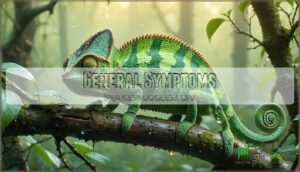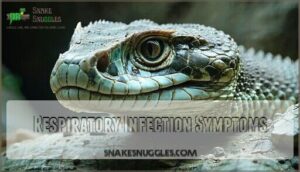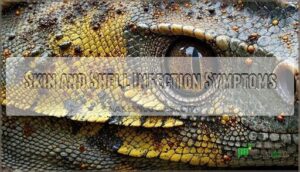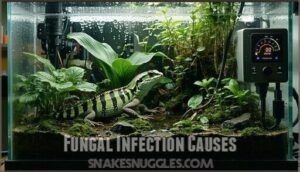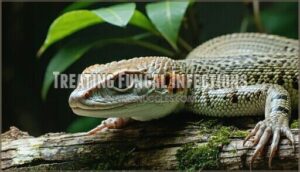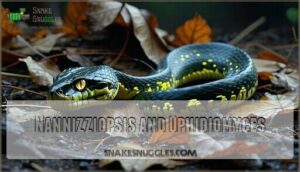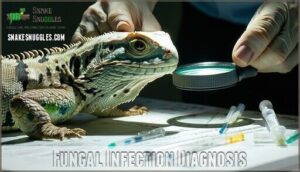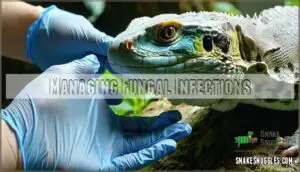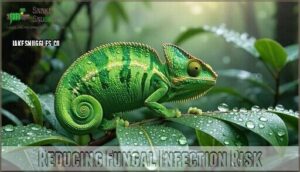This site is supported by our readers. We may earn a commission, at no cost to you, if you purchase through links.

These infections, like dermatomycoses, affect the skin and mucocutaneous junctions, often caused by opportunistic organisms.
You’ll notice symptoms like skin lesions, respiratory issues, or shell infections.
To tackle reptile fungal infections, it’s vital to understand their causes, such as environmental factors, immune system weakness, and poor nutrition.
By recognizing these signs and taking prompt action, you can help your pet recover – and there’s more to learn about effective treatments and prevention strategies.
Table Of Contents
- Key Takeaways
- Reptile Fungal Infections Overview
- Fungal Infection Symptoms
- Fungal Infection Causes
- Treating Fungal Infections
- Preventing Fungal Infections
- Common Fungal Pathogens
- Affected Reptile Species
- Fungal Infection Diagnosis
- Managing Fungal Infections
- Reducing Fungal Infection Risk
- Frequently Asked Questions (FAQs)
- Are pet reptiles at risk for fungal infections?
- Are reptile fungal infections opportunistic?
- How do you treat a fungus in a reptile?
- What should I do if my reptile has an infection?
- How do you know if a reptile has an infection?
- Which reptiles are pathogenic?
- What are the 4 fungal infections?
- Can humans get yellow fungus from reptiles?
- How to get rid of fungal infection in tank?
- Can humans catch fungal infections from reptiles?
- Conclusion
Key Takeaways
- You’ll want to recognize the symptoms of reptile fungal infections, such as skin lesions, respiratory issues, or shell infections, to help your pet recover and prevent serious complications.
- It’s crucial to understand the causes of reptile fungal infections, including environmental factors, immune system weakness, and poor nutrition, so you can take steps to prevent them.
- You should know that treatment options for reptile fungal infections range from antifungal medicines to surgical removal of infected tissue, and it’s essential to work with a veterinarian to determine the best course of action for your pet.
- By maintaining a clean and well-managed environment, providing a balanced diet, and monitoring your reptile’s health, you can reduce the risk of fungal infections and keep your pet healthy, so it’s key to prioritize proper husbandry and care practices.
Reptile Fungal Infections Overview
If you own a reptile, you’ll want to know that fungal infections can affect multiple organ systems and often prove fatal without proper treatment.
Fungal infections can be deadly for reptiles without proper treatment
These infections target the skin, respiratory tract, digestive system, and internal organs, making early recognition and prevention essential for your pet’s survival.
Fungal Diseases Affecting Reptiles
Reptile fungal infections present a growing threat to captive and wild populations worldwide.
These diseases affect multiple organ systems including skin, respiratory tract, and internal organs.
Emerging pathogens like Nannizziopsis and Ophidiomyces show concerning global distribution patterns.
You’ll encounter antifungal resistance in treatment-resistant cases, while some infections carry zoonotic potential.
Their conservation impact threatens vulnerable species populations substantially.
Symptoms of Fungal Infections
You’ll spot reptile fungal disease symptoms through Early Indicators like appetite loss and lethargy.
Behavioral Changes include reduced activity and hiding more often.
Respiratory infections cause breathing difficulty and wheezing.
Skin disorders create slow-healing lesions with foul-smelling discharge.
Lesion Appearance varies from yellow-brown discoloration to crusty patches.
Watch for these reptile symptoms, as fungal diseases progress rapidly without treatment and can be identified by fungal diseases.
Causes of Fungal Infections
Understanding why your reptile develops fungal infections can help you prevent these serious health threats.
Poor sanitation creates breeding grounds for harmful fungi, while temperature imbalance and humidity levels outside ideal ranges weaken your pet’s natural defenses.
Stress from overcrowding or inadequate care compounds these risks.
- High humidity above 70% combined with poor ventilation creates perfect conditions for fungal growth
- Immunosuppression from malnutrition or underlying diseases leaves reptiles vulnerable to opportunistic pathogens
- Nutritional deficiencies prevent proper immune system function, making infections more likely to establish and spread
Fungal Infection Symptoms
Recognizing fungal infection symptoms early can mean the difference between successful treatment and losing your reptile companion.
You’ll need to watch for both general warning signs that affect your pet’s overall health and specific symptoms that target different body systems, including general warning signs.
Watch for general warning signs affecting overall health and specific symptoms targeting different body systems.
General Symptoms
If you’re wondering what lets you know something’s off, it’s usually the big three: Appetite Loss, noticeable Weight Changes, and Lethargy Signs.
These appear before more obvious troubles like reptile skin infection.
Watch for shifts in attitude or routine, as slow-moving or withdrawn reptiles often experience symptom progression.
| Symptom | What to Watch For |
|---|---|
| Appetite Loss | Skipped meals |
| Weight Changes | Thinning or bloating |
| Lethargy Signs | Less activity |
Respiratory Infection Symptoms
Experiencing breathing difficulty, nasal discharge, or open-mouth breathing may indicate respiratory infections in reptiles.
Lethargy signs, anorexia impact, and systemic infections can also occur, making prompt treatment essential for reptile fungal disease, a common reptile disease that can lead to severe complications if left untreated, affecting overall health.
Early detection of localized skin lesions is vital for effective management of reptile disease.
Skin and Shell Infection Symptoms
What makes skin infections particularly troublesome?
Shell lesions and scale discoloration signal deeper problems than surface irritation.
You’ll notice foul odor emanating from infected areas, accompanied by fluid drainage that won’t stop.
Slow healing becomes your biggest clue – healthy reptiles recover quickly, but fungal dermatitis creates persistent wounds.
Scale rot spreads systematically, making early reptile fungal disease diagnosis critical for treatment success.
Fungal Infection Causes
Your reptile’s environment plays a vital role in whether they’ll develop fungal infections, and understanding these risk factors can help you prevent serious health problems.
Several key conditions create the perfect storm for fungal growth, including high humidity levels, poor temperature control, weakened immunity, and inadequate nutrition that leaves your pet vulnerable to opportunistic infections.
Environmental Factors
When you’re dealing with reptile fungal disease causes, your pet’s environment can make or break their health.
Poor husbandry creates the perfect storm for opportunistic infections and fungal pathogens to thrive in your reptile’s home.
Key environmental factors that trigger fungal infections include:
- Humidity Levels – Excessive moisture creates breeding grounds for fungi
- Temperature Control – Cold environments weaken your reptile’s natural defenses
- Enclosure Sanitation – Dirty habitats harbor dangerous microorganisms
- Substrate Choice – Wet or moldy bedding promotes fungal growth
- Ventilation Quality – Poor airflow traps moisture and contaminants.
Monitoring these conditions requires accurate humidity readings.
Immune System Weakness
When your reptile’s immune system weakens, it becomes a sitting duck for opportunistic infections.
Stress factors like overcrowding, temperature fluctuations, and poor husbandry practices suppress reptile immunity, making fungal invasion easier. Malnutrition compounds this vulnerability, while some reptiles face genetic predisposition to immunodeficiency diseases that trigger secondary infections.
You can improve their health with a reptile immune supplement.
| Immune System Factor | Impact on Reptile | Fungal Risk Level |
|---|---|---|
| Chronic stress | Cortisol elevation suppresses immunity | High |
| Malnutrition | Weakens cellular defense mechanisms | Very High |
| Concurrent illness | Diverts immune resources elsewhere | Extreme |
| Poor husbandry | Creates sustained immunosuppression | High |
| Genetic factors | Inherited immune deficiencies | Variable |
Poor Nutrition and Hygiene
While poor immune function sets the stage for infections, inadequate nutrition and unsanitary conditions create the perfect storm for reptile fungal disease.
Malnutrition weakens your pet’s natural defenses, while poor sanitation provides fungal spores with ideal breeding grounds.
Ensuring proper reptile health involves using necessary vitamin supplements.
Key factors that compromise your reptile’s health include:
- Dietary Deficiencies – Lacking vitamins A, C, and essential minerals
- Enclosure Cleaning – Infrequent removal of waste and uneaten food
- Water Quality – Stagnant or contaminated water sources
- Overcrowding Stress – Multiple animals competing for resources and space
Poor substrate choice and inadequate reptile nutrition create environments where fungal pathogens thrive, making reptile fungal disease prevention nearly impossible without proper care protocols.
Treating Fungal Infections
When your reptile shows signs of fungal infection, you’ll need to act quickly since these diseases can be fatal if left untreated.
Treatment options range from prescription antifungal medications to surgical removal of infected tissue, though complete recovery isn’t always possible.
Antifungal Medicines
You’ll use antifungal medicines like Azole antifungals, Polyene antifungals, Allylamines, and Echinocandins to treat reptile fungal infections.
But be aware of resistance development, a significant concern in reptile antifungal treatment, requiring careful antifungal medication selection and monitoring.
Surgical Treatment
You’ll consider surgical treatment for severe reptile fungal disease, which may include:
- Debridement success
- Mass removal
- Post-surgery care, to prevent surgical complications and guarantee effective reptile fungal disease treatment through surgical intervention.
Excessively high humidity and low environmental temperature can increase reptile’s disease susceptibility to fungal disease.
Home Remedies
Several home remedies can help treat minor reptile fungal infections when veterinary care isn’t immediately available.
Tea tree oil mixed with carrier oils provides effective antifungal properties against common pathogens.
Coconut oil demonstrates proven effectiveness against Candida albicans infections.
For skin and shell infections, you can apply dilute povidone-iodine or chlorhexidine solution followed by topical antibiotic ointment to prevent secondary bacterial complications, which is a critical step to prevent secondary bacterial infections.
Preventing Fungal Infections
Prevention is your best defense against fungal infections in reptiles, and it’s much easier than treating an established infection.
You’ll need to focus on three key areas: maintaining spotless habitat conditions, providing proper nutrition, and controlling environmental factors like temperature and humidity.
This will help in preventing fungal infections, with prevention being the core strategy.
Good Sanitation Practices
Your reptile’s home becomes a breeding ground for harmful fungi without proper enclosure cleaning and waste removal.
Establish daily disinfection protocols using reptile-safe cleaners on surfaces, water bowls, and decorations.
Replace substrate regularly to prevent moisture buildup that encourages fungal growth.
Water sanitation prevents contamination, while thorough substrate management eliminates fungal spores.
Consistent sanitation practices, including daily disinfection protocols and regular substrate replacement, form your strongest defense against fungal disease prevention.
Balanced Diet and Nutrition
You can prevent reptile fungal disease by ensuring your pet gets a balanced diet, avoiding nutritional deficiencies, and providing vitamin supplementation.
This approach supports reptile health and care, ultimately aiding in disease prevention through a healthy gut microbiome and proper hydration importance with diet variety.
Optimal Environmental Conditions
Think of your pet’s enclosure as real estate—location and comfort matter.
Control Humidity Levels with precision and offer Temperature Gradients so lizards can play Goldilocks.
Enclosure Size gives room to thrive, while Substrate Choice impacts moisture.
Good Ventilation Needs are the secret handshake against reptile fungal disease and poor environmental factors, keeping reptile health front and center in reptile care and husbandry.
Common Fungal Pathogens
You’ll encounter a variety of fungi that commonly cause infections in reptiles, such as Metarhizium, Aspergillus, Mucor, and Candida.
These pathogens attack different organs, trigger specific symptoms, and sometimes seem to view your pet’s immune system as an all-you-can-eat buffet, which can be triggered by specific factors.
Metarhizium and Mucor
A clean habitat keeps nasty fungi from getting a foothold, but Metarhizium and Mucor still lurk in soil and organic matter.
Metarhizium virulence varies, while Mucor morphology often shows up as fuzzy lesions on your pet.
Reptile susceptibility spikes after stress, and treatment efficacy depends on quick action against these sneaky pathogens, which are common reptile fungal disease types.
Environmental prevalence stays high.
Aspergillus and Candida
When dealing with Aspergillus and Candida, you’ll face:
- Aspergillus Diagnosis challenges
- Candida Treatment difficulties
- Systemic Infections risks, due to opportunistic fungi like Aspergillus and Candida, which can cause reptile fungal disease types, including systemic mycosis.
Nannizziopsis and Ophidiomyces
Nannizziopsis vriesii and Ophidiomyces ophidiicola represent emerging strains causing severe reptile fungal disease.
CANV diagnosis requires specialized molecular testing, while SFD impact devastates wild snake populations.
Treatment resistance complicates therapy for these reptile fungal infections.
Contaminated soil spreads the disease to snakes, and global distribution continues expanding, making these fungal diseases increasingly problematic for reptile keepers worldwide.
Affected Reptile Species
Fungal infections don’t discriminate regarding reptile species, affecting everything from your bearded dragon’s skin to your snake’s respiratory system.
Whether you’re caring for a leopard gecko, iguana, turtle, or any other reptile, understanding which species face the highest risk can help you spot problems early and take action to protect your reptile.
Bearded Dragons and Iguanas
Bearded dragons and iguanas often draw the short straw in regards to species susceptibility.
Yellow fungus disease, caused by CANV, can leave a lasting mark. Quick detection improves treatment efficacy, using antifungals and solid preventative measures.
Reptiles may also suffer from infectious stomatitis, an infection of the mouth lining.
Solid husbandry differences—like good ventilation and low humidity—go a long way toward controlling fungal infections in reptiles and improving reptile fungal disease treatment outcomes.
Snakes and Lizards
Snakes and lizards, they aren’t immune to fungal woes. You might see Snake Ophidiomycosis in your scaled pals. Lizard Dermatophytosis is also a concern. It’s essential to know about CANV in Lizards and SFD Snake Species.
- Lizard Systemic Mycoses can be severe.
- Early reptile fungal disease diagnosis is key.
- Effective reptile fungal disease treatment is available.
- Proper reptile fungal disease management helps to prevent the spread of diseases like Lizard Systemic Mycoses, and it is crucial for the health of snakes and lizards.
Turtles and Tortoises
You’ll find turtles and tortoises susceptible to shell rot and fungal infections, with species susceptibility varying.
Preventative husbandry is key to reducing treatment challenges and long-term effects of turtle fungal infection, a common reptile fungal disease requiring proper diagnosis and vet care for effective reptile fungal treatment.
Fungal Infection Diagnosis
You’ll need to identify the symptoms and signs of fungal infections in your reptile to diagnose the issue.
By examining clinical signs, using fungal cultures and histopathology, and conducting molecular analysis, you can determine the best course of action for your pet’s treatment.
Fungal Cultures and Histopathology
You’ll use fungal cultures and histopathology for diagnosis, including:
- Culture techniques
- Histopathology stains
- Sample collection to facilitate diagnostic accuracy, aiding in reptile fungal diagnosis with full-thickness skin sections and emerging technologies.
Proper identification can differentiate it from other skin infections using histopathology and emerging technologies.
Molecular Analysis and PCR
You’re now exploring molecular analysis and PCR for reptile fungal infections.
PCR identification and sequencing applications help determine genetic diversity, informing phylogenetic analysis and improving diagnostic accuracy in reptile fungal research.
Especially for tricky cases where fungal cultures are unclear, PCR identification and sequencing applications are crucial.
Clinical Signs and Symptoms
You’ll notice early indicators of reptile fungal disease, such as symptom progression and species variations, which pose diagnostic challenges.
Severity correlation is key, as seen in reptile fungal disease images, showing clinical signs like fungal dermatitis in reptiles, which a reptile fungal disease vet can help identify among various reptile diseases, using reorganize methods to improve diagnostic accuracy is not applicable here but the phrase reptile fungal disease is key.
Managing Fungal Infections
You’re now taking steps to manage fungal infections in your reptile, which is essential for their recovery.
By understanding treatment options, secondary infections, and supportive care, you can make informed decisions to help your pet recover from this potentially life-threatening condition.
Treatment Options and Effectiveness
Once you’ve identified the fungal infection through proper diagnosis, you’ll face several reptile fungal disease treatment options with varying success rates.
Antifungal drugs like voriconazole and itraconazole show promise, though antifungal resistance is increasing.
Combination therapies often work better than single medications, and surgical outcomes improve when removing localized infections, but alternative treatments remain limited.
Unfortunately, prognosis factors indicate full recovery stays rare.
Secondary Infections and Complications
Bacterial overgrowth often piggybacks on reptile fungal infections, creating a perfect storm of complications.
Secondary bacterial infections can worsen treatment resistance and accelerate systemic spread throughout your pet’s body. Organ damage becomes more likely when multiple pathogens attack simultaneously, substantially impacting prognosis.
Permanent skin damage frequently occurs when fungal infection complications go untreated, turning manageable conditions into systemic disease. Early detection can improve outcomes when treating snake fungal, which is critical for preventing systemic disease.
Supportive Care and Monitoring
You’ll need to provide round-the-clock supportive care during treatment to help your reptile recover from fungal infections.
Monitor signs daily while ensuring proper thermal support maintains ideal body temperature for healing.
Nutritional support through assisted feeding and hydration therapy prevents dehydration that weakens recovery efforts.
Wound management keeps infected areas clean and protected from further contamination, which is crucial for proper healing and maintaining the reptile’s overall health, including thermal support.
Reducing Fungal Infection Risk
You can reduce the risk of fungal infections in your reptiles by maintaining a clean and well-managed environment.
By following proper husbandry practices, providing a balanced diet, and monitoring your reptiles’ health, you can help prevent fungal infections and keep your pets healthy.
Biosecurity and Quarantine
You’ll implement isolation protocols, disinfection methods, and vector control to prevent reptile fungal disease.
Effective quarantine duration and source tracking are essential for disease management and sanitation, aiding in fungal disease prevention and reptile diseases management, which involves implementing these methods to achieve disease management.
Husbandry and Environmental Management
You manage reptile fungal disease prevention through proper husbandry, including Humidity Control, Temperature Gradients, and Enclosure Design.
While substrate choice and sanitation also play key roles in disease management, building on quarantine protocols to keep your reptiles healthy, with proper husbandry being crucial.
Nutrition and Health Monitoring
Your reptile’s dietary impact is vital. Consider:
- Supplement needs
- Hydration levels
- Weight management
- Regular checkups
to prevent reptile fungal disease, ensuring effective reptile diagnosis, treatment, and prevention in veterinary medicine.
Frequently Asked Questions (FAQs)
Are pet reptiles at risk for fungal infections?
You’re basically inviting a tiny, unwanted roommate if you don’t keep your pet’s environment clean, making them vulnerable to fungal infections.
Are reptile fungal infections opportunistic?
You’ll find that opportunistic fungi, like Aspergillus and Candida, often cause infections in reptiles, exploiting weakened immune systems and poor environmental conditions to thrive and spread.
How do you treat a fungus in a reptile?
You’ll likely use antifungal medicines, and in severe cases, surgery to remove fungal masses, followed by antibiotic treatment to prevent secondary infections, under veterinary guidance, of course.
What should I do if my reptile has an infection?
You should consult a veterinarian immediately if your pet has an infection, as prompt treatment with antifungal medications and proper care can help prevent serious complications.
How do you know if a reptile has an infection?
You’ll notice signs like weight loss, lack of appetite, or breathing troubles, serving as red flags that your reptile may have an underlying infection that needs attention.
Which reptiles are pathogenic?
You’ll see pathogenic reptiles like bearded dragons, iguanas, and snakes, which are prone to fungal infections, particularly yellow fungus, and require proper care to prevent and manage these diseases effectively.
What are the 4 fungal infections?
You’ll encounter four key fungal infections: dermatophytosis, candidiasis, aspergillosis, and ophidiomycosis, each affecting different reptile species and requiring distinct treatment approaches for effective management and care.
Can humans get yellow fungus from reptiles?
You won’t directly catch yellow fungus from reptiles, but poor hygiene and contact with infected animals can increase your risk of fungal infections, so handle them carefully and wash hands.
How to get rid of fungal infection in tank?
For example, cleaning the tank with a bleach solution can help; you’ll need to remove animals, wash decorations, and disinfect all surfaces to get rid of fungal infections.
Can humans catch fungal infections from reptiles?
You can catch fungal infections from reptiles, but it’s rare; poor hygiene and weakened immunity increase your risk of contracting diseases like ringworm or dermatophytosis from infected animals.
Conclusion
Like a knight fighting a dragon, you’re now equipped to battle reptile fungal infections.
You’ve learned about symptoms, treatments, and prevention strategies.
By recognizing signs of reptile fungal infections, you can help your pet recover, so remember, prompt action is key to tackling these infections and keeping your reptile friend healthy, which is the ultimate goal of learning about reptile fungal infections.
- https://www.ncbi.nlm.nih.gov/pubmed/?term=(reptile)+AND+(fungal)+AND+(infection)
- https://www.cabi.org/vetmedresource/search/?q=(reptile)+AND+(fungal)+AND+(infection)
- https://linkinghub.elsevier.com/retrieve/pii/S1094-9194(03)00013-6
- http://journals.elsevierhealth.com/retrieve/pii/S1094-9194(03)00013-6
- https://medlineplus.gov/fungalinfections.html

